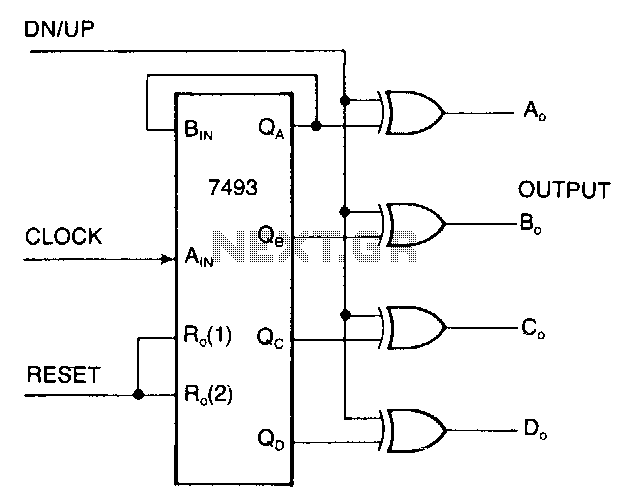
Eight-digit-microprocessor-display

The display interface utilizes the ICM7218A/B in conjunction with an 8048 family microcontroller. An 8-bit data bus (DBO/DB7-IDO/ID7) facilitates the transfer of control and data information to the 7218 display interface during successive WRITE pulses. The mode input pins on the microcontroller determine the type of data being transferred. When the mode is set to high, a control word is sent; when the mode is set to low, data is transmitted. Each successive WRITE pulse automatically loads sequential locations in the 8-byte static memory. After eight WRITE pulses, additional pulses are disregarded until a new control word is received.
The ICM7218A/B is a versatile display driver capable of managing multiple types of displays, including LED and LCD configurations. It interfaces directly with microcontrollers, such as those from the 8048 family, providing an efficient means of displaying numerical or graphical data. The 8-bit data bus allows for the transmission of both control commands and data, ensuring that the display can be updated dynamically based on the microcontroller's operations.
The microcontroller's mode input pins play a crucial role in determining the operational state of the interface. By setting the mode high, the microcontroller signals the ICM7218A/B to accept a control word, which may include commands for display configuration or mode changes. Conversely, setting the mode low allows for the transmission of actual data to be displayed. This dual-mode capability enhances the flexibility of the interface, allowing for a wide range of applications.
The automatic loading of sequential memory locations with each WRITE pulse simplifies the process of updating the display. This feature reduces the need for complex programming, as the microcontroller can simply send a series of WRITE pulses to load new data into the display without requiring additional commands for each memory location. However, it is important to note that after eight WRITE pulses, the system will ignore any further pulses until a new control word is received. This design choice prevents data overflow and ensures that the display remains in a stable state while awaiting new instructions.
Overall, the integration of the ICM7218A/B with an 8048 family microcontroller creates a robust and efficient display interface, suitable for various applications requiring real-time data representation. The architecture supports both control and data transmission, enabling seamless operation and ease of use in electronic designs.Display interface uses the ICM7218A/B with an 8048 family microcontroller. The 8-bit data bus (DBO/ DB7-IDO/ID7) transfers control and data information to the 7218 display interface on successive WRITE pulses. The mode input pins on the microcontroller. When mode is high, a control word is transferred; when mode is low, data is transferred. Sequential locations in the 8-byte static memory are automatically loaded on each successive WRITE pulse.
After eight WRITE pulses have occurred, further pulses are ignored until a new control word is transferred. 🔗 External reference
The ICM7218A/B is a versatile display driver capable of managing multiple types of displays, including LED and LCD configurations. It interfaces directly with microcontrollers, such as those from the 8048 family, providing an efficient means of displaying numerical or graphical data. The 8-bit data bus allows for the transmission of both control commands and data, ensuring that the display can be updated dynamically based on the microcontroller's operations.
The microcontroller's mode input pins play a crucial role in determining the operational state of the interface. By setting the mode high, the microcontroller signals the ICM7218A/B to accept a control word, which may include commands for display configuration or mode changes. Conversely, setting the mode low allows for the transmission of actual data to be displayed. This dual-mode capability enhances the flexibility of the interface, allowing for a wide range of applications.
The automatic loading of sequential memory locations with each WRITE pulse simplifies the process of updating the display. This feature reduces the need for complex programming, as the microcontroller can simply send a series of WRITE pulses to load new data into the display without requiring additional commands for each memory location. However, it is important to note that after eight WRITE pulses, the system will ignore any further pulses until a new control word is received. This design choice prevents data overflow and ensures that the display remains in a stable state while awaiting new instructions.
Overall, the integration of the ICM7218A/B with an 8048 family microcontroller creates a robust and efficient display interface, suitable for various applications requiring real-time data representation. The architecture supports both control and data transmission, enabling seamless operation and ease of use in electronic designs.Display interface uses the ICM7218A/B with an 8048 family microcontroller. The 8-bit data bus (DBO/ DB7-IDO/ID7) transfers control and data information to the 7218 display interface on successive WRITE pulses. The mode input pins on the microcontroller. When mode is high, a control word is transferred; when mode is low, data is transferred. Sequential locations in the 8-byte static memory are automatically loaded on each successive WRITE pulse.
After eight WRITE pulses have occurred, further pulses are ignored until a new control word is transferred. 🔗 External reference